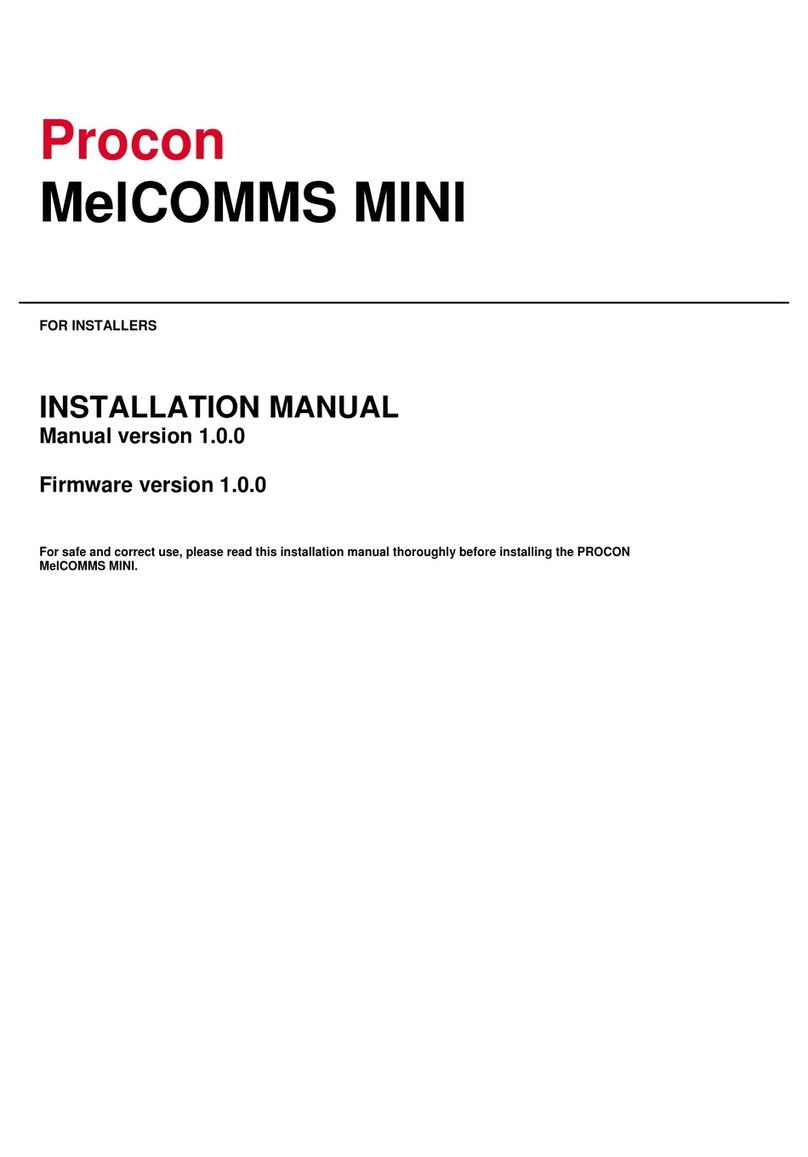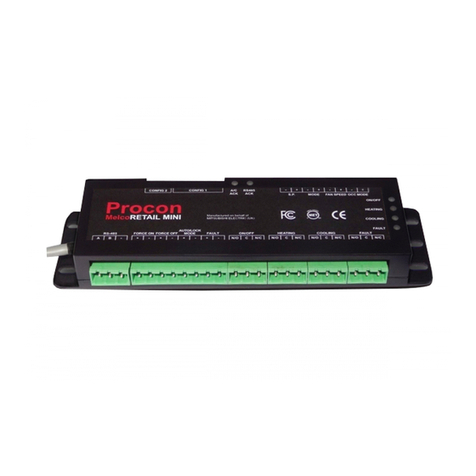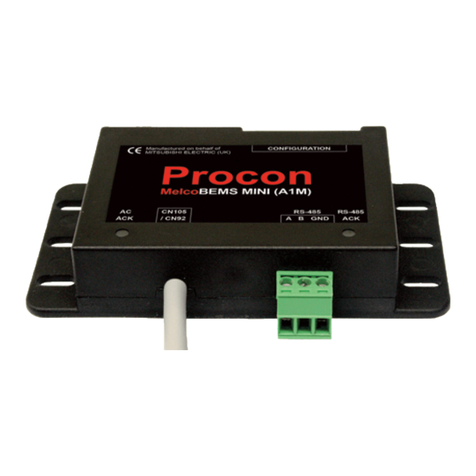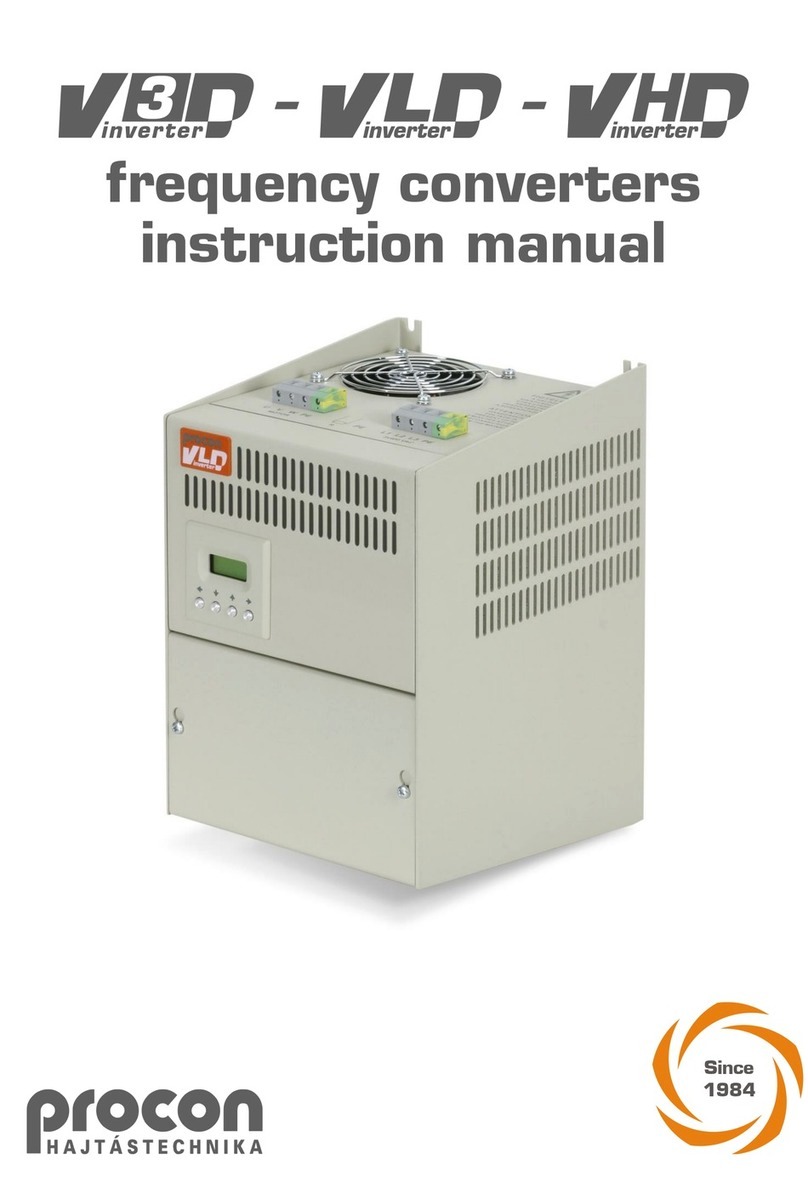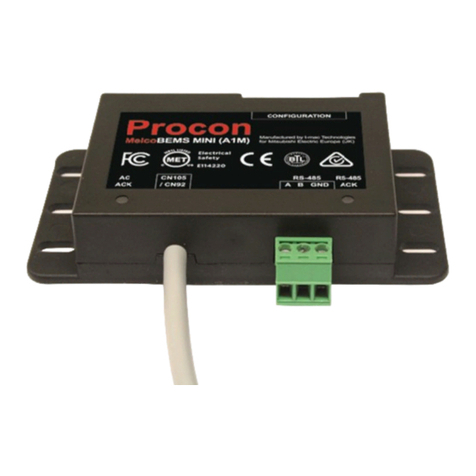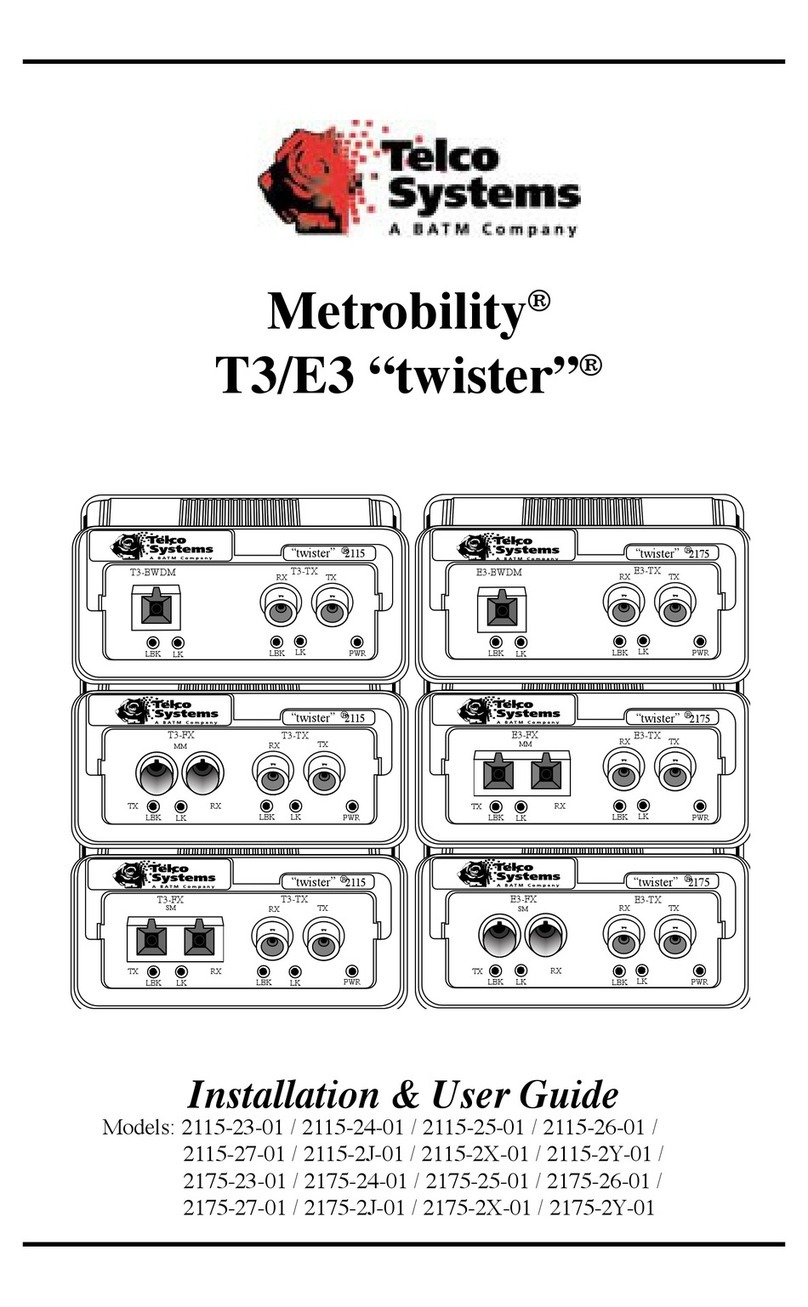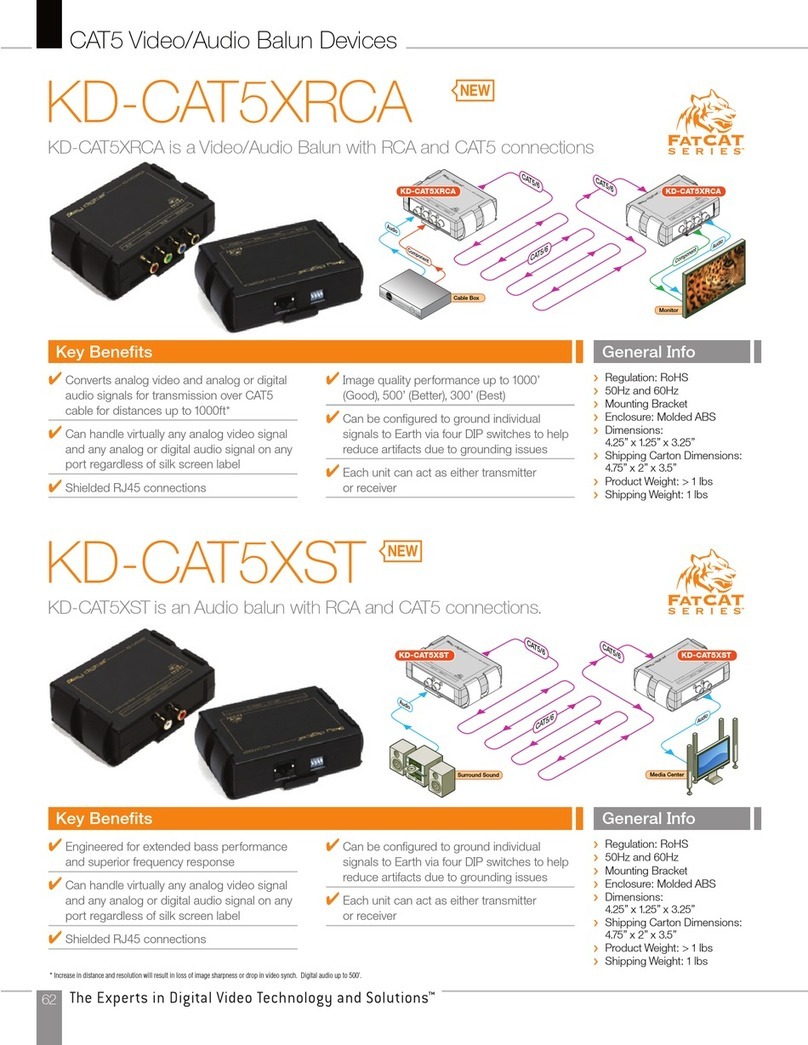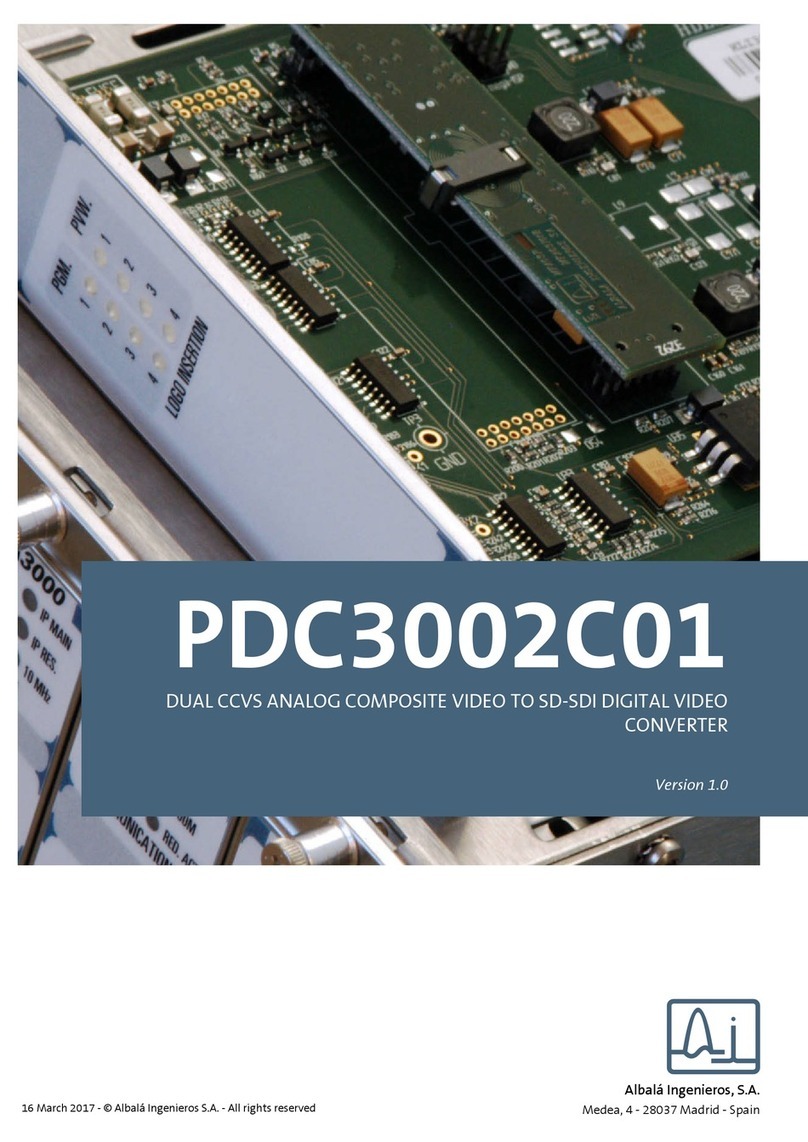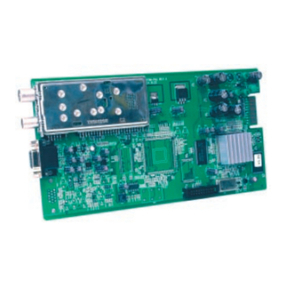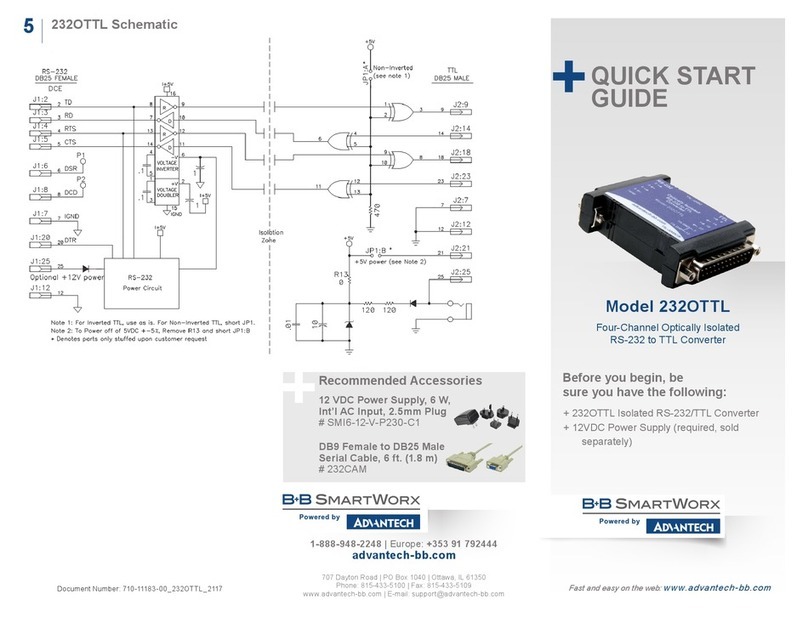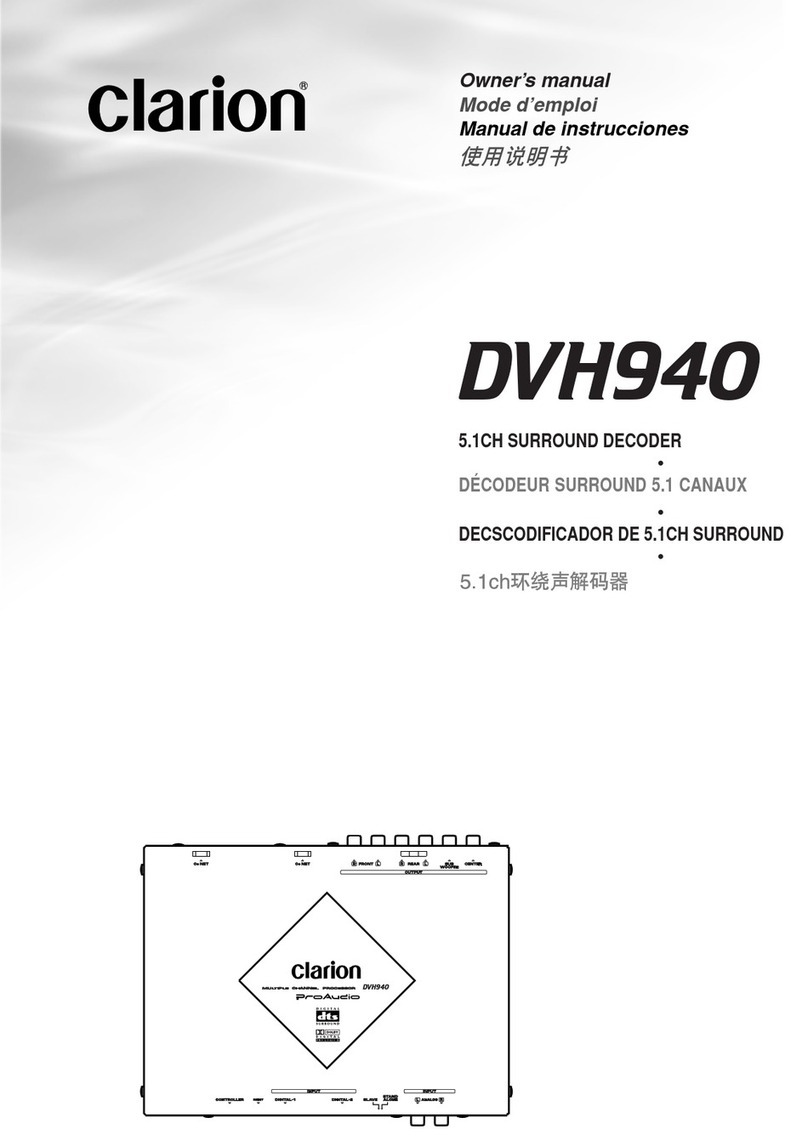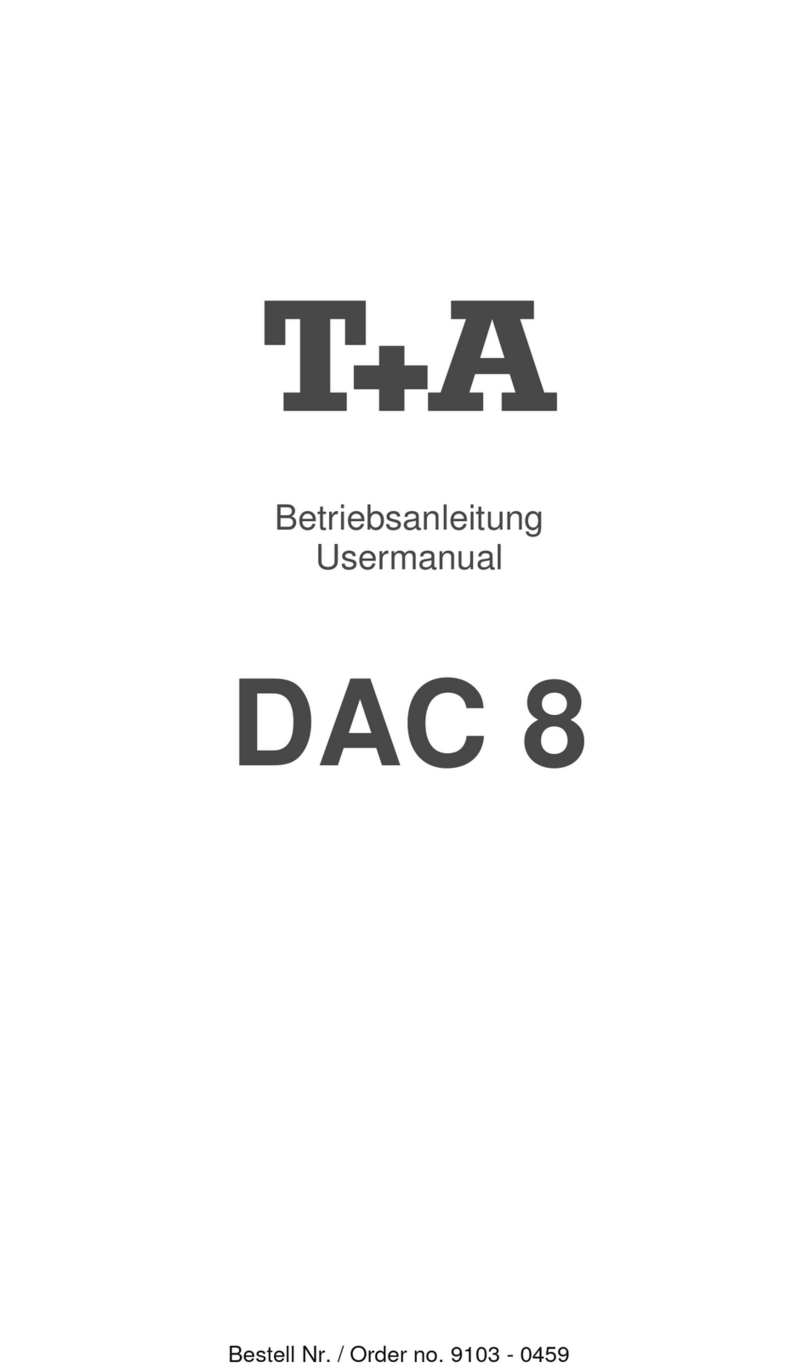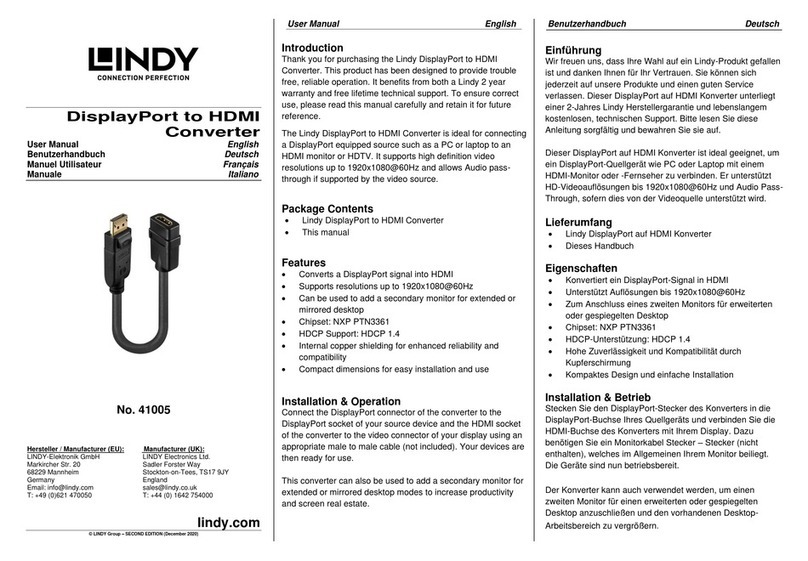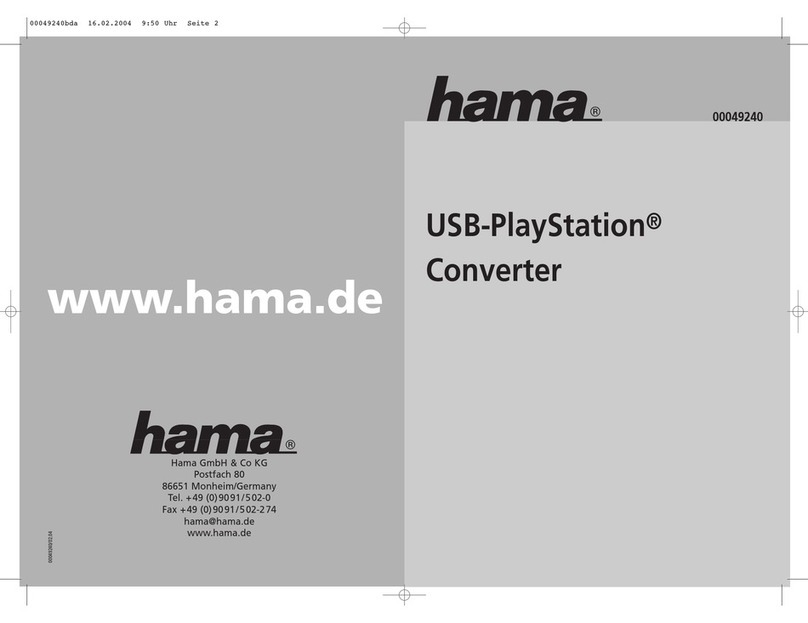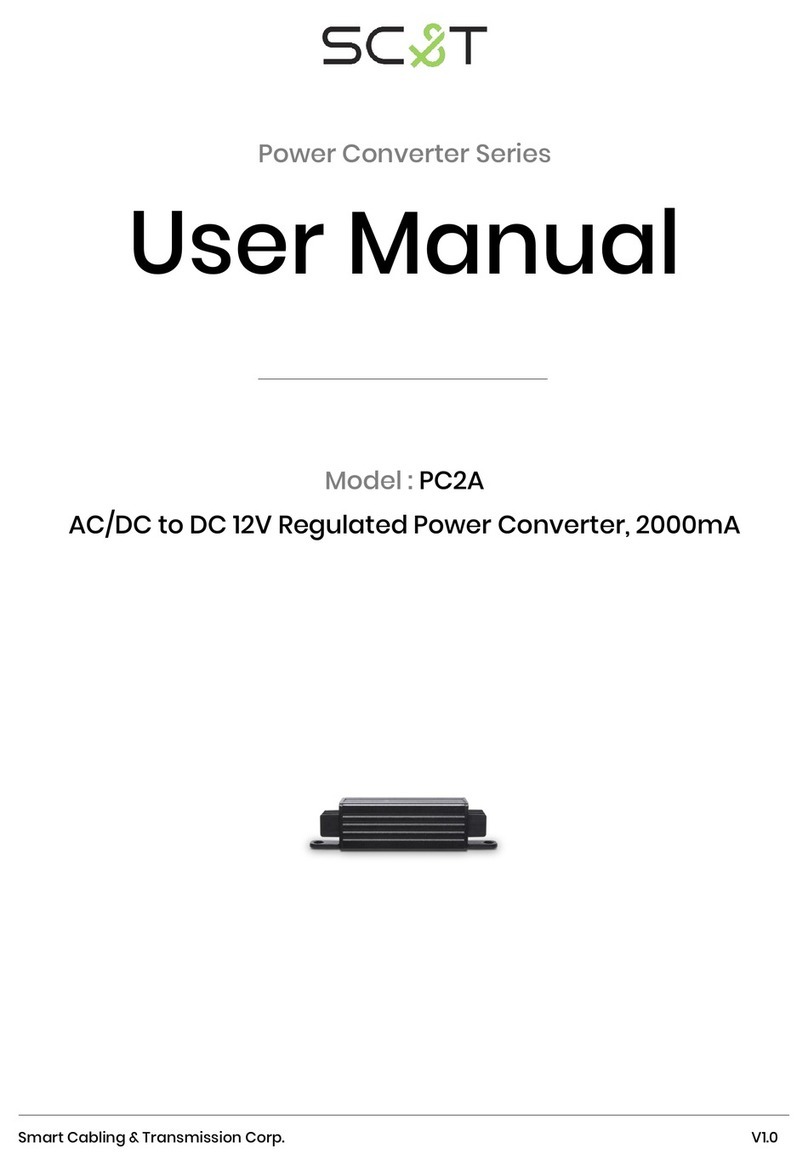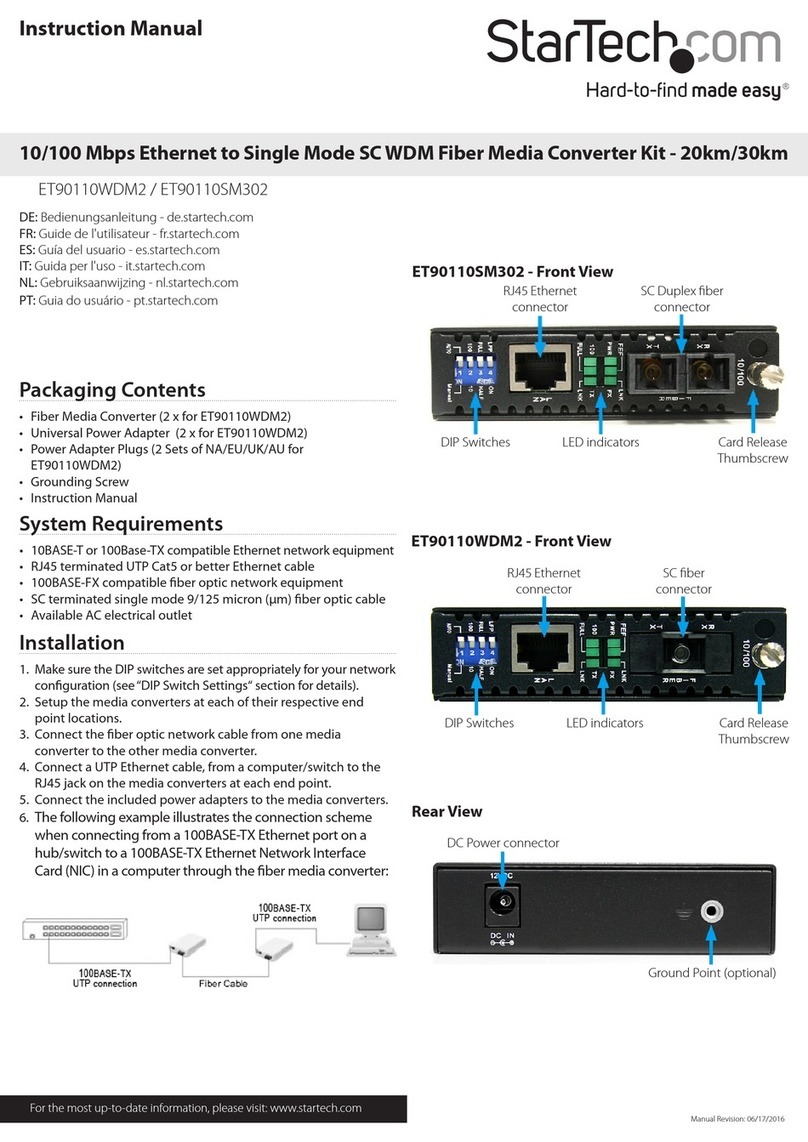Procon E3D 0.55 User manual

F
frequency converters
instruction manual 0,55 –4kW
from software version V164
P
Since
1984


FFREQUENCY CONVERTERS INSTRUCTION MANUAL 0,55 ÷ 4 kW
- 3 -
TABLE OF CONTENTS
APPLICATION............................................................................................................................................................. 4
GENERAL FEATURES ............................................................................................................................................... 4
FUNCTIONING ............................................................................................................................................................ 5
DECLARATION OF CONFORMITY............................................................................................................................ 5
MECHANICAL INSTALLATION.................................................................................................................................. 5
TEST RUN ................................................................................................................................................................... 6
Cables and fuses.......................................................................................................................................................... 7
Main and Control Circuit Wiring ................................................................................................................................... 8
Connecting the power line ................................................................................................................................. 8
Connecting the motor......................................................................................................................................... 8
Connecting the protective earth......................................................................................................................... 8
Connecting the control circuitry.......................................................................................................................... 8
PUTTING IN OPERATON THE FREQUENCY CONVERTER FOR THE FIRST TIME.............................................. 9
ASSIGNMENT AND CONNECTION OF THE E3D TERMINAL BLOCK ................................................................. 10
OPERATING THE CONVERTER.............................................................................................................................. 11
Controlling terminal .................................................................................................................................................... 11
Functions of the push buttons.......................................................................................................................... 11
PROGRAMMING ....................................................................................................................................................... 12
Programming procedure ............................................................................................................................................ 12
Menu system.............................................................................................................................................................. 12
Description of the special functions available at the digital inputs................................................................... 13
Parameter values in the display................................................................................................................................. 15
Error List..................................................................................................................................................................... 15
DRIVING TECHNOLOGY SUPPLEMENTS.............................................................................................................. 16
Potentiometer............................................................................................................................................................. 16
Selection of the brake resistors at dynamic braking .................................................................................................. 16
MAINTENANCE......................................................................................................................................................... 16
GUARANTEE AND REPAIR..................................................................................................................................... 16
FREQUENCY CONVERTER SELECTION GUIDE................................................................................................... 17
PERIPHERAL EQUIPMENT SELECTION GUIDE ................................................................................................... 18

FFREQUENCY CONVERTERS INSTRUCTION MANUAL 0,55 ÷ 4 kW
- 4 -
Dear Customer!
Thank you for having decided in favour of PROCON Ltd’s frequency converter.
This Instruction Manual contains all information necessary for starting up and operating the frequency
converter. Read this manual before installing the frequency converter.
Follow all safety measures, warnings and instructions described in this manual.
The manufacturer bears no responsibility for any personal injury and/or material damage arising from not
taking into consideration the warnings in this manual.
At receiving the frequency converter, please check up followings:
▪Make sure that the frequency converter is not damaged. If you detect any damage of the frequency
converter contact the manufacturer.
▪Check the data plate of the device to make sure that you received the ordered model. If not, please contact
the manufacturer
Following graphic symbols will be used in this manual:
6
This symbol is used for those instructions whose negligence could cause electric shock, severe injury or
even death.
7
This symbol is used for those instructions whose negligence could cause fire and injury.
8
This symbol is used for those instructions whose negligence could cause personal injury, damage in the
equipment and property damage.
i
Important information
APPLICATION
The E3D series frequency converters are digitally programmable appliances.
They are suitable for the near loss-free regulation of the rotation speed of any type of three-phase asynchronous
motors with squirrel-cage rotor from 0.55 kW to 11 kW power ratings, at 400 V.
The converters comply with the requirements of the standards relating to control devices for use in the electric
industry.
GENERAL FEATURES
Line voltage
3 x 380 ÷ 440 V AC ± 10 %
Line frequency
50 ÷ 60 Hz (sine wave)
Motor voltage
3 x 0 ÷ actual value of the input voltage (PWM modulated sine wave)
Motor frequency
0 ÷ 400 Hz (free programmable)
Protection grade
IP20 (optionally IP54)
Line filter
built-in RF filter at the input side
Ambient temperature
0°C ÷ +40 °C
Relative humidity
maximum 90 % (non-condensing)
Storage temperature
-20 °C ÷ +60 °C
Requirements for the
place of the installation
Install the drive in an area free from:
▪oil, oil mist, dust, metal shavings, water or other foreign materials,
▪combustible materials (e.g., wood),
▪harmful gases and liquids,
▪excessive vibration,
▪chlorides,
▪direct sunlight
Orientation
The frequency converter must always be mounted in vertical position, with provision
for the ventilation requirements.

FFREQUENCY CONVERTERS INSTRUCTION MANUAL 0,55 ÷ 4 kW
- 5 -
FUNCTIONING
The alternating voltage from the power line is rectified by a line diode bridge, then electrolytic capacitors smooth out the
pulsating voltage. The intelligent IGBT end stage, driven with sinusoidal modulated pulses, delivers to the motor a
voltage of variable amplitude and frequency. Up to the nominal speed of the motor the voltage vs. frequency is constant.
At low frequencies the ohmic resistance of the motor winding can be compensated (U boost).
Below the nominal revolution the frequency converter is capable of delivering nominal torque; beyond it the
converter delivers constant power.
The converter can be equipped with an optional braking resistor.
DECLARATION OF CONFORMITY
The frequency converters have been manufactured with considering following directives:
Frequency converters
E3D
Machinery directive
2006/42/EK
Low voltage directive
2014/35/EU
Electromagnetic Compatibility (EMC) directive
2014/30/EU
Applied standards
EN 13849-1:2008
EN 61800-5-2:2016
EN 60034-1:2017
EN 61800-5-1:2007
EN 60664-1:2008
EN 61800-3:2017
8CAUTION
These products serve for being mounted into machineries.
These products are allowed to be put into service only after the machinery comprising the product was found to
comply with the above directives about machineries.
According to the directions on electromagnetic compatibility (EMC) the listed products are not considered as
products which can be operated alone. The electromagnetic compatibility can only be evaluated after the product
was incorporated in the whole system. Certification of this evaluation refers not to the stand-alone product but to
the complete machinery.
MECHANICAL INSTALLATION
The appliance belongs to protection class IP-20 and is allowed to be operated as a built-in unit only.
Should the appliance need increased protection due to the conditions (water, dust, aggressive materials), use at
least protection IP-54. If the appliance is installed by the user, the issues cooling and arranging the cables need to
be consulted with the manufacturer.
8CAUTION
The manufacturer takes no responsibility for damages caused by incorrect installation.
200
50
FREQUENCY
CONVERTER
▪Beside the side walls at least 50mm, below and above the unit at least 200
mm free space must be provided.
▪If the device is built in closed control cabinet, overheating of the inside room
must be prevented with proper ventilation!
▪The slots for fresh air and used air must be held free to assure proper
ventilation. The filters of the slots must be cleaned regularly!
▪At IP54 versions the cooling is facilitated with heatsinks of increased size
that must be placed outside the cabinet, with maintaining the IP54
protection!
▪On demand the manufacturer builds the equipment in a cabinet of proper
size.
▪At types with forced ventilation the inlet openings should be on the bottom
side, the ventilated outlets on the upper side (possible diagonally)

FFREQUENCY CONVERTERS INSTRUCTION MANUAL 0,55 ÷ 4 kW
- 6 -
TEST RUN
In the course of the installation and test run the manufacturer’s attached wiring instructions and the instructions of
the effective standards must be complied with.
8CAUTION
Test run, maintenance, repair and component replacement in the frequency converter are allowed to be
performed by authorized specialist only!
6WARNING
ELECTRICAL SHOCK HAZARD
Negligence of these warnings could cause severe injury or even death!
Prior to the total discharge of the capacitors the terminal blocks of the motor must not be touched!
Prior to wiring the connectors of the device switch off the whole power supply of the device! The internal
capacitor remains in charged state even after switching off the power supply. Installation is allowed to be started
if the power LED has ceased lighting.
When taking the equipment from could environment to the place of installation vapour may condense.
Prior to installation wait until the temperature of the equipment equalizes with that of the environment and the
device becomes totally dry.
The appliance must not be put into operation in humid environment.
The circuitries of the frequency converter must not be modified or changed.
In switched-on state the covering of the device must not be removed and any part of it must not be
touched!
The appliance must be earthed according to the standards.
8CAUTION
DANGER OF UNEXPECTED STARTING
Negligence of this warning could cause injury and property damage!
On switching the line power to the frequency converter, the device depending on its setting may
unexpectedly start the motor.
Prior to powering the frequency converter make sure that nobody stays near to the motor and the machine and
all coverings, mechanical connections, wedges, bolts and machine load are properly fastened!
7WARNING
FIRE HAZARD
Negligence of this warning could cause fire and injury!
The power line cable must not be connected to the output motor connections of the frequency converter!
Connecting the power line to the output connections could cause severe damage in the device.
Tighten all terminal screws to the specified tightening torque.
Loose electric connections may overheat.
Terminal Size
M3
M4
M5
Tightening Torque [Nm]
0.8 ÷ 1.0
1.2 ÷ 1.5
2.0 ÷ 2.5

FFREQUENCY CONVERTERS INSTRUCTION MANUAL 0,55 ÷ 4 kW
- 7 -
8CAUTION
EQUIPMENT HAZARD
Negligence of this warning could cause total damage to the device.
The device is not waterproof!
Prevent the interior of the appliance from the penetration of water!
Take care that no external object (e.g. small metal part, metal powder) or liquid can get inside the device.
Avoid short circuit or ground fault at the output terminal blocks.
It is forbidden to connect any capacitor to the output. Regarding other filters, please ask the
manufacturer’s opinion.
Avoid using contactor at the output because the frequency converter may stop working due to switch-on
overcurrent.
If for other reasons using a contactor is necessary (e.g. switch-over between motors), the switchover of the
output of the frequency converter during operation must be prevented by latching.
Use the shortest possible earthing conductor and avoid earth loops.
Earthing conductors common with machines of higher power (e.g. welding machine, machine tool) must
not be used.
For wiring the control unit use shielded cable.
Use shielded twisted wires, and connect the shielding to the reference point of the inputs.
Observe proper electrostatic discharge procedures (ESD) when handling the frequency converter.
Failure to comply may result in ESD damage to the drive circuitry.
Do not operate the device with any visible damage on it or if its any part is missing.
Do not modify the circuitry of the frequency converter to avoid damages and expiring of the warranty.
Check all the wiring to ensure that all connections are correct after installing the frequency converter
and connecting other devices.
•Cables and fuses
At connecting the frequency converters use mains fuses and wires with cross-section as given in the table.
TYPE
Minimum
fuse value
(F)
[A]
Recomm.
cable
[mm2]
E3D 0.55
6.3
0.75 ÷ 1
E3D 0.75
6.3
1 ÷ 1.5
E3D 1.1
6.3
1 ÷ 1.5
E3D 1.5
10
1.5 ÷ 2.5
E3D 2.2
10
1.5 ÷ 2.5
E3D 3
16
2.5 ÷ 4
E3D 4
16
2.5 ÷ 4

FFREQUENCY CONVERTERS INSTRUCTION MANUAL 0,55 ÷ 4 kW
- 8 -
•Main and Control Circuit Wiring
•Connecting the power line
At connecting the power line comply with following safety measures:
▪Use only circuit breakers that have been designed specifically for frequency converters.
▪If an input switch is used, it is allowed to be used not more than once in every 30 minutes.
▪Use an AC reactor on the input side of the drive:
•to suppress harmonic current,
•to improve the power factor on the power supply side,
•when using an advancing capacitor switch.
•Connecting the motor
At connecting the motor comply with following safety measures:
▪The output of the frequency converter has to be loaded with a three-phase motor. In case of any other load
consult with the manufacturer!
▪Never connect a power source to the drives output.
▪Never short or ground the output terminals.
▪Do not use phase correction capacitors.
▪If using a contactor between the drive and motor, it should never be operated when the drive is outputting a
voltage. Operating while there is voltage output can cause large peak currents, thus tripping the over current
detection or damage the drive.
▪For connecting the output it is recommended to use shielded cable with earthing at both ends.
▪With an output cable of longer than 30 meters, an output choke coil has to be used. If the cable length
exceeds 200 meters, the output choke coil is not enough, because of the excessive capacitive load. In this
case, a sine filter has to be used. Regarding the output choke coil or the sine filter, please ask the
manufacturer’s opinion.
•Connecting the protective earth
At connecting the earthing of the frequency converter comply with following safety measures:
▪Never share the ground wire with other devices such as welding machines, etc.
▪Always use a ground wire that complies with electrical equipment technical standards. Keep ground wires as
short as possible. Leakage current is caused by the drive. Therefore, if the distance between the ground
electrode and the ground terminal is too long, potential on the ground terminal of the drive will become
unstable.
▪When using more than one frequency converter, do not to loop the ground wire.
▪Use earth cable of same cross-section as that of the phase conductors.
•Connecting the control circuitry
At connecting the control circuitry comply with following safety measures:
▪Separate control circuit wiring from main circuit wiring and other high-power lines.
▪The connections of the SR connectors of the control circuitry (digital output) have to be separated from other
connectors of the control circuitry, unless they are used for control purposes.
▪In order to avoid operation errors use twisted pair or shielded twisted pair cables for connecting the control
circuitry.
▪Be sure to earth the shielding with the largest possible contact area between shielding and earth connection.
▪The shieldings have to be earthed at the frequency converter side of the cables.

FFREQUENCY CONVERTERS INSTRUCTION MANUAL 0,55 ÷ 4 kW
- 9 -
PUTTING IN OPERATON THE FREQUENCY CONVERTER FOR THE FIRST TIME
8CAUTION
Prior to put in operation the frequency converter read through thoroughly the description below!
Follow all safety measures, warnings and instructions described in this manual!
Heed the safety messages in this manual.
The operating company is responsible for any injuries or equipment damage resulting from failure to heed the
warnings in this manual.
▪Check up the operational data of the frequency converter to be put in operation.
page 4. - General features
▪Install the device according to the instructions.
page 5. - Mechanical installation
▪Study the safety measures to be complied with.
page 6. - Test run
▪Connect the cables of the power line, the motor and the control elements to the corresponding terminal
blocks.
page 10. - Assignment and connection of the E3D terminal block
▪If the device is equipped with brake check up the value and the placing of the brake resistor.
page 16. - Selection of the brake resistors at dynamic braking
▪Switch the line power to the device.
▪At devices without controlling terminal the motor can be started with the device’s control elements according
to the default setting (or the required setting).
▪At devices with controlling terminal check up and if necessary modify the preset parameters (rising times and
fall times, minimum and maximum frequency etc.)
▪If possible, perform a trial start with unloaded motor:
•inspect the operation of the motor,
•in case of opposite direction of rotation interchange both phase wires of the motor to achieve the right
basic direction of rotation,
i
Interchanging the phase wires at the mains side does not influence the direction of
rotation!
•with changing the reference signal (e.g. potentiometer) scan the operating frequency band,
•try the functioning of the other controls (e.g. reversing)
▪Let the motor run with load!
▪If necessary modify the parameters (rising times and fall times, minimum and maximum frequency etc.)
▪In regulating mode tune the PI parameters (17.PropG, 18.IntTm)

FFREQUENCY CONVERTERS INSTRUCTION MANUAL 0,55 ÷ 4 kW
- 10 -
ASSIGNMENT AND CONNECTION OF THE E3D TERMINAL BLOCK
L1 L2 L3 PE
MOTOR R BRAKE LINE
SA SD
1 12 23 34 4 5
U V W PE
+24V
E3D frequency converter
0÷10V
REVERSING
ERROR A.
EXT. ERROR
remote transmitter
500Ω
min. 0,5W
M
~3 x 400VAC
F1 F2 F3
2 10K÷
SR
1 2
ST
(0÷ 02 mA)
4÷ 02 mA
Three-colour LED (green: On, yellow: Operate, red: Error, flashing yellow: Waiting)
SA1
+10V potentiometer driving output (max. 6 mA)
SA2
Analogue input 1 (reference signal): potentiometer (2÷10 kΩ), 0÷10 V, 4÷20 mA (0÷20 mA) *
SA3
GND (reference point of the inputs)
SA4
Analogue input 2 (feedback signal): 0÷10 V, 4÷20 mA (0÷20 mA) *
SD1
Digital input 1 (factory setting: start switch)
SD2
Digital input 2 (factory setting: reversing switch)
SD3
Digital input 3 (factory setting: error acknowledgement)
SD4
Digital input 4 (factory setting: external error)
SD5
+24V/D supply voltage output (max. 100 mA) (for digital inputs, remote transmitter)
ST1
Spare
ST2
SR1
Digital output 1 ** (factory setting: ready - closing / error - opening)
SR2
SR3
Option (Digital output 2 **) (factory setting: operate - closing / stop - opening)
SR4
* Current inputs (4÷20 mA, 0÷20 mA) have to be terminated with a 500 Ω resistor. (1 %, 0,5÷1 W)
** Digital outputs: relay (max. 250 V AC / 1 A or 30 V DC / 0,5 A) or optocoupler (optional) (max. 30 V DC / 10 mA)

FFREQUENCY CONVERTERS INSTRUCTION MANUAL 0,55 ÷ 4 kW
- 11 -
OPERATING THE CONVERTER
The source of the reference signal can be:
▪external or front panel potentiometer,
▪0÷10 V,
▪4÷20 mA (0÷20 mA),
▪front panel controlling terminal,
▪motor potentiometer
The source of the logical control signals can be:
▪terminal blocks
•Controlling terminal
f=50.0Hz
Im=0.8A
ESCAPE ENTER
▪This terminal allows programming, displaying 2 parameters
and reference signal generation.
▪Equipped with a 2x8 character display and 4 push buttons.
▪Reading in display mode: first row –frequency, second row –
other measured variables (e.g. voltage, current), which can be
scrolled with the arrows.
▪Reading in programming mode: first row –name of the
parameter along with its serial number in the menu
(e.g. 21.TRUp), second row –the actual value of the parameter
(e.g. 5,00s) that can be modified with the push buttons.
▪The terminal can be used built in the front panel of the
frequency converter only!
•Functions of the push buttons
(Escape)
▪Change between display mode and programming mode
▪Parameter setting mode: shift the cursor to the left
▪Repeated push: exit parameter setting mode without saving (until the cursor blinks)
▪At error display: displaying the cause of the error
▪Display mode: scrolling the displayed variables downward
▪Programming mode: moving in the menu downward
▪Parameter setting: decreasing the value or scrolling the selector switches downward
▪With selected terminal motor potentiometer: decreasing the reference signal
▪With enabled motor potentiometer start / stop: Stop
▪Display mode: scrolling the displayed variables upward
▪Programming mode: moving in the menu upward
▪Parameter setting: increasing the value or scrolling the selector switches upward
▪With selected terminal motor potentiometer: increasing the reference signal
▪With enabled motor potentiometer start / stop: Start
(Enter)
▪Programming mode: starting the parameter setting
▪Parameter setting mode: shift the cursor to the right
▪Repeated push: save parameter value (until the cursor blinks)
▪Acknowledgement at error

FFREQUENCY CONVERTERS INSTRUCTION MANUAL 0,55 ÷ 4 kW
- 12 -
PROGRAMMING
•Programming procedure
(Escape)
▪Changing from display mode to programming mode
▪Moving between the menu items
(Enter)
▪Starting parameter setting
▪Parameter setting
(Enter)
▪Repeated push: save parameter value (until the cursor blinks)
or
(Escape)
▪Repeated push: exit parameter setting mode without saving (until the cursor blinks)
•Menu system
Submenu
Description, further submenus
Value, range
Default setting
Unit
11. CRef
Control reference
Value of the output frequency in control mode,
with the terminal as reference signal source.
0,1 - 400,0
1,0
Hz
12. RRef
Regulation ref.
Value of the reference signal in regulation mode,
with the terminal as reference signal source.
0,00 - 100,00
0,00
%
13.OpMod
Operation mode
Selecting the operation mode
Normal: increasing frequency to incr. error signal,
Inverse: decreasing frequency to incr. error signal,
Signed: normal regulation with change of the
direction of rotation.
Control
Normal regulation
Inverse regulation
Signed regulation
Control
-
15.CRefS
Control reference
source
Selecting the source of the control reference
signal.
Analogue In 1
Terminal
Term. motor pot.
Motor pot.
Analogue In 1
-
16.RRefS
Regulation
reference source
Selecting the source of the regulation reference
signal.
Analogue In 1
Terminal
Term. motor pot.
Motor pot.
Analogue In 1
-
17.PropG
Proportional gain
Regulation parameter.
0,00 - 19,00
0,50
-
18.IntTm
Integration time
Regulation parameter. With IntTm=N proportional
regulation can be performed.
N
1 - 20000
1000
ms
19.DZone
Dead zone
With signed proportional regulation, if the error
signal is within the dead zone, the output
frequency is zero.
N
0,01 - 100,00
N (0,00)
%
21.TRUp
Run-up time
Run-up time of the frequency from 0 Hz to fmax
in both the control and the regulation process.
0,05 - 3276,7
5,00
s
31.TRDwn
Run-down time
Run-down time of the frequency from fmax to 0
Hz in both the control and the regulation process.
0,05 - 3276,7
5,00
s
32.StopM
Stop mode
Stopping can be made with run-out, normal
braking and DC braking.
With free run, the converter accepts a new start
command after the run-down time.
With DC braking, duration of the brake operation
equals to the run-down time, during this time a
new start command can be sent out.
With mixed braking (normal + DC), switch-over
frequency is 1Hz, DC braking time 2 s.
Resistor brake can be enabled for each stop
mode.
Free run
Free run + R br.
Normal brake
Normal + R brake
DC brake
DC + R brake
Mixed brake
Mixed + R brake
Normal brake
-

FFREQUENCY CONVERTERS INSTRUCTION MANUAL 0,55 ÷ 4 kW
- 13 -
Submenu
Description, further submenus
Value, range
Default setting
Unit
41.AnIn1
Analogue input 1
(Reference signal)
Programming the lower value and the function of
the reference signal (stop band, 0V/mA, 4mA).
The stop band is active in control mode only
(indicated by flashing yellow LED).
With regulation, 0V/mA will be interpreted by the
program.
Stop band
0V/mA
4mA
0V/mA
-
42.AnIn2
Analogue input 2
(Feedback signal)
Programming the lower value of the feedback
signal.
When selecting Umotor, the motor voltage can be
steadily varied between the actual value and its
50%.
0V/mA
4mA
Umotor
0V/mA
-
43.DgIn1
Digital
input 1
Special function for selecting the commands!
Special functions
Start switch
-
44.DgIn2
(Setting identical with that of 43.DgIn1)
Reversing switch
-
45.DgIn3
Error ack.
46.DgIn4
External error
•Description of the special functions available at the digital inputs (43 to 46)
Start switch: Continuous start command. If more than one input is programmed for start switch, they are in logical
AND relation. All of them must be true for effecting a start command.
Start push button: Pulse type start command. If more than one input is programmed for start push button, they
are in logical OR relation. If any of them is true start command will be sent out.
Reversing switch: Activating the input results in a reversing command. If more than one input is programmed for
reversing switch, then activating each further input results in reversing the direction of the rotation. Example: with
two digital inputs programmed for reversing switch, activating both inputs results in reversing command, that is, the
original direction will be valid.
Jogging: Usually used for adjusting the machinery, starts the motor with the frequency set in menu 83.FJog.
Active is from stop state only.
External error: Causes the appliance to stop with running out on error message (e.g. motor thermal switch,
emergency off, etc.)
Error acknowledgement: Acceptance of the error messages, removal of the disable state.
Stop closing: With closing contact causes the motor to stop according to the preset stopping mode.
Stop opening: With opening contact causes the motor to stop according to the preset stopping mode.
Free run: Causes the motor to stop with running out. When activated, the frequency converter allows the motor to
stop freely.
DC brake: Causes the motor to stop with DC braking. When activated in stop state, the resulting standing torque
permits achieving hold function.
F fixed: The appliance goes to the frequency preset in menu 84.FFix according to the actual run-up and run-down
value.
Motor potentiometer up: With motor potentiometer reference signal, input for increasing the reference signal.
Motor potentiometer down: With motor potentiometer reference signal, input for decreasing the reference signal.
Control/Regulation: Dynamic changeover of the operation modes.
Analogue input swap: Swaps the analogue inputs with each other.

FFREQUENCY CONVERTERS INSTRUCTION MANUAL 0,55 ÷ 4 kW
- 14 -
Submenu
Description, further submenus
Value, range
Default setting
Unit
47. MP 0
Motor potentiom.
reference signal
zero set
Selects zero set of the motor potentiometer
reference signal.
None
At switch-on
On start
At dir. change.
None
-
48. MPSP
Motor potentiom.
start/stop
In Stop state pushing the button once results
in starting and going to minimum frequency.
After that the requested frequency can be set
with the and push buttons.
In Start state at minimum frequency pushing the
button once results in stopping.
No
Yes
No
-
51. DgO1
Digital output 1
Selecting the function of the relay or optocoupler
output.
Error signal < 1%: Display of having reached the
preset value.
Ready to operate
Error signal < 1%
Operation
Forward
F max
F min
Error
Ready to operate
-
52. DgO2
Digital output 2
At models E1D 1.5 to 2.2 and E3D 0.37 to 4 only.
(Setting identical with that of 51.DgO1)
61. PMot
Nominal power
Identification of the motor used with the
frequency converter.
Setting this parameter is very important for the
precise motor protection!
0.10 - 4.00
Depending on
type
kW
62. ILim
Current limit
Limitation of the motor current not to exceed the
preset value.
0.5 - 15.0
Depending on
type
A
63. FMot
Nominal
frequency
Frequency belonging to the nominal motor
voltage. This value sets the upper frequency
corner point of the U vs. f characteristics.
0,1 - 400,0
50,0
Hz
64. UMot
Nominal voltage
Nominal line voltage of the motor.
This is the voltage the motor obtains at f ≥ fmot
(Menu item 63). This value sets the upper voltage
corner point of the U vs. f characteristics.
100,0 - 400,0
Depending on
type
V
65.CoolM
Cooling mode
With prolonged use below 15 Hz forced cooling
must be set or used.
Internal
External
Internal
71.Boost
Starting voltage
The initial voltage the standing motor starts from.
Serves compensating the ohmic losses.
0.0 - 60.0
Depending on
type
V
81. FMax
Max. frequency
The highest frequency the motor can be fed with.
It has priority over the maximum frequency.
Even if the frequency reference signal is set
higher, fmax will be valid.
* default setting is 100,0Hz for frequency converters
without operating terminal
0,1 - 400,0
50,0
Hz
82. FMin
Min. frequency
The lowest frequency the motor can be fed with,
except for the starting and stopping process.
Even if the frequency reference signal is set
lower, fmin will be valid.
0,1 - 399,9
1,0
Hz
83. FJog
Jogging
frequency
Low frequency periodical mode usually used for
adjusting the machinery.
Activation can occur from stop state only!
0,1 - 100,0
5,0
Hz
84. FFix
Fixed frequency
In start state, with the activated digital input set to
FFix, this frequency will be valid independently of
the reference signal source and the operation
mode.
0,1 - 400,0
1,0
Hz
99. ErrL
Error list
After pushing the (Enter) button the last four errors can be displayed, using the buttons.

FFREQUENCY CONVERTERS INSTRUCTION MANUAL 0,55 ÷ 4 kW
- 15 -
•Parameter values in the display
Row
Values
Short
First row (fix)
Actual frequency
f
Second row
The values can be
scrolled with the
arrows
Motor current
Control reference signal
Regulation reference signal
Feedback signal
Line voltage
DC voltage
Motor voltage
Heat sink temperature
„Total” operating hour counter
„Run” operating hour counter
Im
Cr
Rr
Fs
Ul
U+
Um
Th
O1
O2
•Error List
Display
Description of the error
Troubleshooting
Cleared
No more error in the error log. (Display in basic state)
Ext.Err
Digital input programmed to external error
activated.
Inspect the device causing the external error.
L.Ph.Err
Line phase error. (at E3D series models)
Inspect the presence of all 3 phases.
Rippled
DC voltage rippled. (at E3D series models)
I Meas
Current measuring error. (e.g. broken or
shorted signal wire)
Internal error.
Troubleshooting to be done by the manufacturer.
Mot.Hot
In the actual mode the motor would probably
be overheated. Probably too low frequency or
overloaded operation.
Effecting forced cooling, and then in menu item
65.CoolM setting the forced cooling to the
necessary value or decreasing the load.
BrakeErr
Load of the brake resistor too high.
Increase the run-down time in menu item
32.StopM.
Over Cur
The current developed through the motor
exceeded the maximum value.
Decrease the load of the motor.
DC High
The DC voltage in the intermediate circuit
exceeded the permitted limit.
With power factor corrector in front of the
appliance:
▪insert line choke in front of the appliance.
If occurs during the stopping process:
▪increase the run-out time in menu item
32.StopM
Hs.Hot
Heatsink temperature too high.
▪At device equipped with built-in ventilator
checking up of its rotation beyond 45C,
▪at device built in cabinet checking up the
ventilation of the cabinet,
▪checking up the extent of the loading of the
device.
IGBT Err
The IGBT module signalized error. Typical
effect in case of an output short circuit.
Checking up the wiring and connections between
the device and the motor.
MemWrErr
Memory writing error.
After acknowledgment of the error, if the
converter is in Stop state, try to set the
parameters once again.
DataStE
Error in the stored data.
Disconnect the converter from the line.
If the LEDs do not light anymore, the appliance
can be restarted.
CHKSUM
Checksum error.
IIC Err
Internal communication error.
COM PWM
Internal communication error.
COM IO
Internal communication error.
UnknErr
Unknown error.
If the error cannot be removed with applying the troubleshooting guide and acknowledgement, contact the
manufacturer.

FFREQUENCY CONVERTERS INSTRUCTION MANUAL 0,55 ÷ 4 kW
- 16 -
DRIVING TECHNOLOGY SUPPLEMENTS
•Potentiometer (2 ÷ 10 kΩ, linear)
Bekötés:
1 2 3
Frequency conv.
terminal blocks
Potentio-
meter
SA 1
1
SA 2
2
SA 3
3
•Selection of the brake resistors at dynamic braking
The power on the brake resistor depends on the braking time and the duty factor. (Pnominal / 50 ÷ Pnominal)
The necessary power is determined by the braking time and the duty factor.
Frequency
converter type
Resulting
resistance
E3D 0.55 ÷ 1.1
≥ 200 Ω
E3D 1.5 ÷ 4
≥ 100 Ω
▪100 W wire-wound
resistors
(50÷200 Ω)
▪500 W wire-wound
resistors
(50÷100 Ω)
▪2÷4 kW cased brake
resistor modules
(12,5÷100 Ω)
8CAUTION
The brake resistors are imposed to high voltages of 660 V DC.
The appliance must be installed and wired very carefully because of heat developing and for proper
electric shock protection.
For wiring use cables with heat-resisting coating.
MAINTENANCE
At normal operation the device needs no maintenance. Depending on the surroundings inspect regularly the
ventilators, and at models built in cabinet also the condition of the filter cartridge.
Inspect the screwed fastenings according to the local maintenance regulations, but at least once a year.
GUARANTEE AND REPAIR
The products come with a guarantee period of 24 months.
8CAUTION
The guarantee covers normal operation only.
In case of improper storage, improper use or unauthorized intervention the guarantee terminates.
Repair will be accomplished both within the guarantee period and after in the manufacturer’s premises, the
appliance has to be transported there by the user.

FFREQUENCY CONVERTERS INSTRUCTION MANUAL 0,55 ÷ 4 kW
- 17 -
FREQUENCY CONVERTER SELECTION GUIDE
0.55
0.75
1.1
1.5
2.2
3
4
5.5
7.5
11
15
22
30
37
45
55
75
90
110
132
160
200
250
(kW)
F
H
I
J
TYPE
Output
power
[kW]
Nominal
current
[A]
Peak
current
[A]
Mass
[kg]
Physical dimensions [mm]
Fastening
screws
Width
Length
Height
Fastening
Three phase, 3 x 380 ÷ 440 V AC input
E3D 0.55
0.55
1.7
2.3
1.5
100
220
107
70 x 210
4 x M4
E3D 0.75
0.75
2.6
4
1.5
100
220
107
70 x 210
4 x M4
E3D 1.1
1.1
3.2
5
2
100
240
144
70 x 230
4 x M4
E3D 1.5
1.5
4.2
6
3
100
240
144
70 x 230
4 x M4
E3D 2.2
2.2
6
9
3
100
240
144
70 x 230
4 x M4
E3D 3
3
8
12
4
100
270
176
70 x 260
4 x M4
E3D 4
4
10
14
4
100
270
176
70 x 260
4 x M4
E3D 5.5
5.5
14
19
6
128
290
220
105 x 280
4 x M5
E3D 7.5
7.5
18
30
8
128
390
220
105 x 380
4 x M5
E3D 11
11
26
37
8
128
390
220
105 x 380
4 x M5

FFREQUENCY CONVERTERS INSTRUCTION MANUAL 0,55 ÷ 4 kW
- 18 -
PERIPHERAL EQUIPMENT SELECTION GUIDE
ITEM
E3D
V3D
VLD
VHD
3 x 400 V line voltage
Built-in mains noise suppressor
IP20 cabinet
IP54 cabinet
Analogue input 1 - 2
Analogue input 3 - 4
–
±10V analogue input
–
–
Analogue output 1 - 2
–
Digital input 1 - 4
Digital input 5 - 6
–
Digital input 7 - 8
–
–
Digital output 1
Digital output 2
Digital output 3
–
–
RS-485 serial line 1 (Terminal)
–
RS-485 serial line 2 (System)
–
USB / RS 485 interface
–
RS 485 / 485 interface (optical light cable type)
–
USB / RS 485 interface (optical light cable type)
–
CAN bus 1
–
CAN bus 2
–
–
Reception of incr. rotation speed encoder 1
–
Reception of incr. rotation speed encoder 2
–
–
Built-in dynamic brake
Brake resistor
Mains (input) choke
Output (motor) choke
Stand-alone programming terminal (4 x 16)
–
Built-in programming terminal
–
–
–
Stand-alone operating terminal (2 x 16)
–
Built-in operating terminal
–
–
–
External operating terminal
–
Built-in controlling terminal (2 x 8)
Built-in display (4 x 16)
–
–
–
External display
–
Built-in potentiometer
External potentiometer
Markings
Basic configuration
Option
–Not applicable


PROCON Hajtástechnika Kft.
H-1047 Budapest, Kisfaludy u. 4.
Tel./fax: +36 1 370 9699
+36 1 379 5387
e-mail: [email protected]
Internet: www.procon.hu
Edition: April, 2018
I
II III
IV
VVIII
IX X
XI
XII
XIII XIV
XV
XVI
XVII
XVIII
XIX
XX
XXI
XXIII
XXII
Barossu.
Váciút
Tímáru.
Nyitrau.
Tinódiu.
PerényiZsigmondu.
Kisfaludyu.
Sörétgyáru.Semmelweisu.
Labdarúgóu.
Labdaverőu.
Mildenbergeru.
Bányagépgyáru.
Dunasor
Megyeriút
This manual suits for next models
6
Table of contents
Other Procon Media Converter manuals
